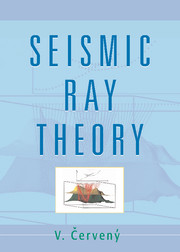Book contents
- Frontmatter
- Contents
- Preface
- 1 INTRODUCTION
- 2 THE ELASTODYNAMIC EQUATION AND ITS SIMPLE SOLUTIONS
- 3 SEISMIC RAYS AND TRAVEL TIMES
- 4 DYNAMIC RAY TRACING. PARAXIAL RAY METHODS
- 5 RAY AMPLITUDES
- 6 RAY SYNTHETIC SEISMOGRAMS
- APPENDIX A FOURIER TRANSFORM, HILBERT TRANSFORM, AND ANALYTICAL SIGNALS
- References
- Index
4 - DYNAMIC RAY TRACING. PARAXIAL RAY METHODS
Published online by Cambridge University Press: 03 February 2010
- Frontmatter
- Contents
- Preface
- 1 INTRODUCTION
- 2 THE ELASTODYNAMIC EQUATION AND ITS SIMPLE SOLUTIONS
- 3 SEISMIC RAYS AND TRAVEL TIMES
- 4 DYNAMIC RAY TRACING. PARAXIAL RAY METHODS
- 5 RAY AMPLITUDES
- 6 RAY SYNTHETIC SEISMOGRAMS
- APPENDIX A FOURIER TRANSFORM, HILBERT TRANSFORM, AND ANALYTICAL SIGNALS
- References
- Index
Summary
Dynamic ray tracing is a powerful procedure that has recently found broad applications in the evaluation of high-frequency seismic wavefields in laterally inhomogeneous layered structures and in the solution of inverse seismic problems. It consists of solving a system of several ordinary differential equations along a known ray Ω and yields the first derivatives of phase space coordinates of points on Ω (position, slowness vector components) with respect to initial phase space coordinates or ray parameters. Although the dynamic ray tracing system is very simple and can be integrated without any larger additional numerical effort, in contrast with standard ray tracing, it extends the possibilities of the standard ray method considerably.
The dynamic ray tracing system can be expressed in many forms and in various coordinate systems. Certain versions of the system have been known for a long time. For example, dynamic ray tracing was used by Belonosova, Tadzhimukhamedova, and Alekseyev (1967) to calculate geometrical spreading in 2-D laterally varying isotropic structures. The dynamic ray tracing system for 3-D laterally varying anisotropic media in general Cartesian coordinates was first proposed and applied to the computation of geometrical spreading by Červený (1972). A similar procedure of calculating geometrical spreading in a 3-D laterally varying isotropic layered structure was discussed in detail by Červený, Langer, and Pšenčík (1974). The reference also gives the relations for dynamic ray tracing across a structural interface. For dynamic ray tracing in general nonorthogonal coordinates in isotropic layered and blocked structures, see Červený, Klimeš, and Pšenčík (1988b). For spherical coordinates, see Liu and Tromp (1996) and Dahlen and Tromp (1998).
- Type
- Chapter
- Information
- Seismic Ray Theory , pp. 234 - 416Publisher: Cambridge University PressPrint publication year: 2001
- 1
- Cited by



